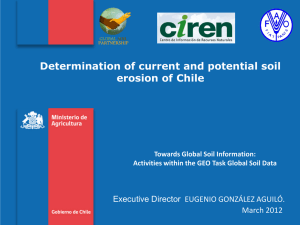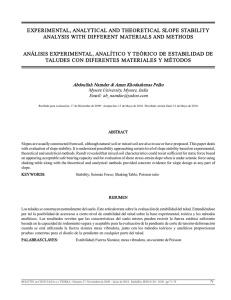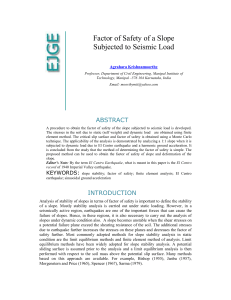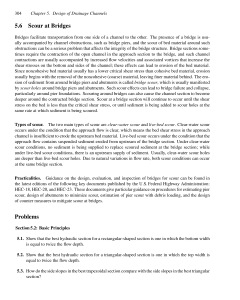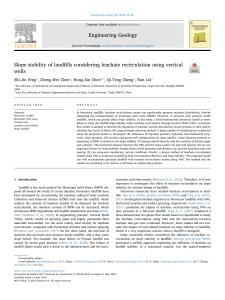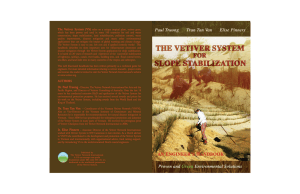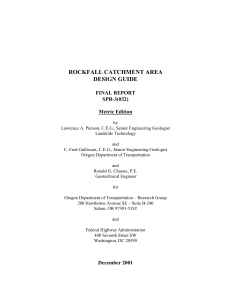historical review of topographical factor, ls, of water erosion models
Anuncio
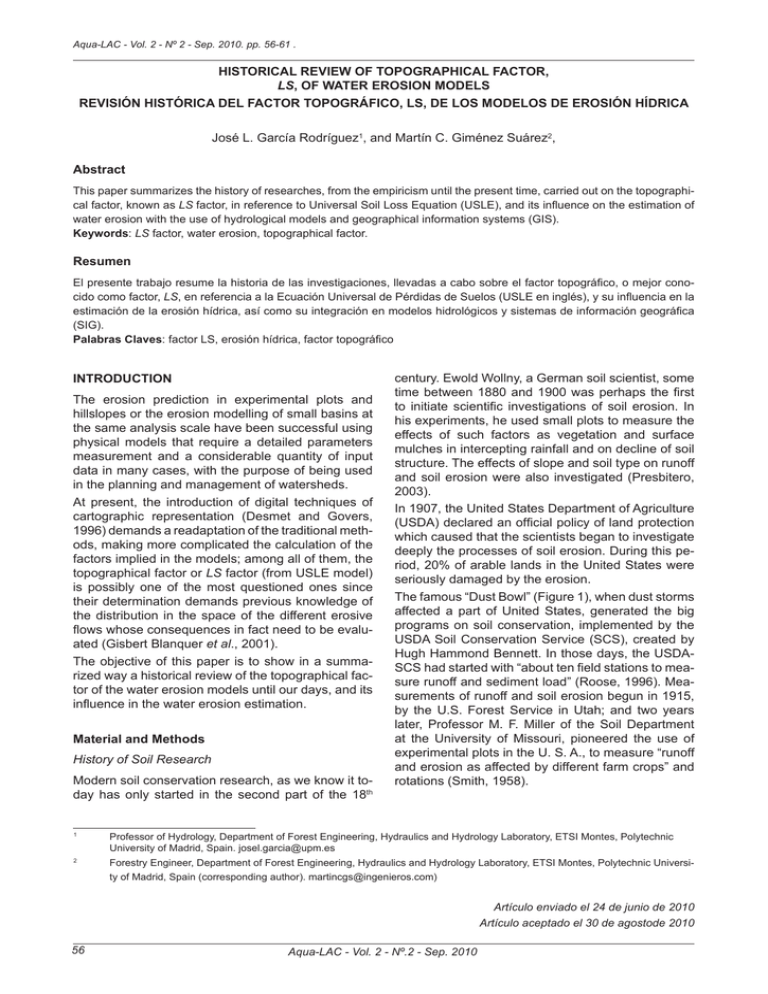
Aqua-LAC - Vol. 2 - Nº 2 - Sep. 2010. pp. 56-61 . HISTORICAL REVIEW OF TOPOGRAPHICAL FACTOR, LS, OF WATER EROSION MODELS REVISIÓN HISTÓRICA DEL FACTOR TOPOGRÁFICO, LS, DE LOS MODELOS DE EROSIÓN HÍDRICA José L. García Rodríguez1, and Martín C. Giménez Suárez2, Abstract This paper summarizes the history of researches, from the empiricism until the present time, carried out on the topographical factor, known as LS factor, in reference to Universal Soil Loss Equation (USLE), and its influence on the estimation of water erosion with the use of hydrological models and geographical information systems (GIS). Keywords: LS factor, water erosion, topographical factor. Resumen El presente trabajo resume la historia de las investigaciones, llevadas a cabo sobre el factor topográfico, o mejor conocido como factor, LS, en referencia a la Ecuación Universal de Pérdidas de Suelos (USLE en inglés), y su influencia en la estimación de la erosión hídrica, así como su integración en modelos hidrológicos y sistemas de información geográfica (SIG). Palabras Claves: factor LS, erosión hídrica, factor topográfico Introduction The erosion prediction in experimental plots and hillslopes or the erosion modelling of small basins at the same analysis scale have been successful using physical models that require a detailed parameters measurement and a considerable quantity of input data in many cases, with the purpose of being used in the planning and management of watersheds. At present, the introduction of digital techniques of cartographic representation (Desmet and Govers, 1996) demands a readaptation of the traditional methods, making more complicated the calculation of the factors implied in the models; among all of them, the topographical factor or LS factor (from USLE model) is possibly one of the most questioned ones since their determination demands previous knowledge of the distribution in the space of the different erosive flows whose consequences in fact need to be evaluated (Gisbert Blanquer et al., 2001). The objective of this paper is to show in a summarized way a historical review of the topographical factor of the water erosion models until our days, and its influence in the water erosion estimation. Material and Methods History of Soil Research Modern soil conservation research, as we know it today has only started in the second part of the 18th century. Ewold Wollny, a German soil scientist, some time between 1880 and 1900 was perhaps the first to initiate scientific investigations of soil erosion. In his experiments, he used small plots to measure the effects of such factors as vegetation and surface mulches in intercepting rainfall and on decline of soil structure. The effects of slope and soil type on runoff and soil erosion were also investigated (Presbitero, 2003). In 1907, the United States Department of Agriculture (USDA) declared an official policy of land protection which caused that the scientists began to investigate deeply the processes of soil erosion. During this period, 20% of arable lands in the United States were seriously damaged by the erosion. The famous “Dust Bowl” (Figure 1), when dust storms affected a part of United States, generated the big programs on soil conservation, implemented by the USDA Soil Conservation Service (SCS), created by Hugh Hammond Bennett. In those days, the USDASCS had started with “about ten field stations to measure runoff and sediment load” (Roose, 1996). Measurements of runoff and soil erosion begun in 1915, by the U.S. Forest Service in Utah; and two years later, Professor M. F. Miller of the Soil Department at the University of Missouri, pioneered the use of experimental plots in the U. S. A., to measure “runoff and erosion as affected by different farm crops” and rotations (Smith, 1958). 1 Professor of Hydrology, Department of Forest Engineering, Hydraulics and Hydrology Laboratory, ETSI Montes, Polytechnic University of Madrid, Spain. josel.garcia@upm.es 2 Forestry Engineer, Department of Forest Engineering, Hydraulics and Hydrology Laboratory, ETSI Montes, Polytechnic University of Madrid, Spain (corresponding author). martincgs@ingenieros.com) Artículo enviado el 24 de junio de 2010 Artículo aceptado el 30 de agostode 2010 56 Aqua-LAC - Vol. 2 - Nº.2 - Sep. 2010 Historical Review of Topographical Factor, LS, of Water Erosion Models With the funds of the United States Congress for erosion research, H. H. Bennett and L. A. Jones of the USDA established ten experimental stations to measure and study the erosion in the more affected areas in the United States during the period 1928 to 1933 (Smith, 1958). Baver, Borst, Woodburn, Musgrave and Zingg opened the way in the analytic investigations of the processes in the soil erosion in the 30´s. The observation plots ranged in size from 2 to 7 m in width and from approximately 10 to 200 m in length. It result with the first empiric equation to estimate soil erosion, introduced by Baver in 1933, and which incorporated dispersion, absorption, soil permeability and soil particles size (Presbitero, 2003). Investigations Review About Slope Gradient And Slope Length Effect On Water Erosion Most investigation activities on soil erosion and their control have been done on relatively flat terrains. Traditionally, steeplands (usually referred to slopes above 20%) were considered for agricultural use, for that reason, the investigation in these slopes has been abandoned. Other investigators like McDonald, Liu and Tang consider slope gradient of 30% as the lower limit to be considered a steepland. The statistical models used to describe the effect of the slope inclination or gradient (expressed in either sin of the slope angle or percent slope) in the soil loss caused on hillsides by rainfall and runoff, can adopt the lineal, power or polynomial forms (Liu, Nearing and Risse, 1994). Liu, Nearing and Risse (1994) found that within the slope gradient range of up to about 25%, all these functional forms of soil loss predictive equations provide quite similar values, but they become different beyond this slope gradient. Using field inspections in 1936, Renner carried out the pioneering investigation on the effects of slope inclination (without considering the slope longitude), aspect, soil, vegetation type and density, and accessibility to livestock, on the soil erosion on the rangelands of Boise River watersheds (USA). The maximum effect of slope steepness was found at about 35% slope (here, slope percent is defined as 100 tan θ where θ is the slope angle in degrees). Inaccessibility to grazing animals was identified as the most likely reason for the decrease in soil erosion beyond the 35% slope (Presbitero, 2003). For superficial flow, in 1945, Horton developed a relationship between slope length, slope gradient and soil surface shearing force. With slope gradient defined as tan θ (θ is the slope angle in degrees), the developed relationship predicted maximum soil loss at 30° slope, and which was assumed as zero at 90° slope. However, when sin θ was adopted as the definition for the slope gradient, the predicted maximum soil loss occurred at 90° slope. Zingg (1940) analyzed simulated rainfall data, on crop lands of clay and sand from Kansas and on clay from Alabama, (USA) was observed, in both situations, that the soil loss varied with the slope gradient (up to 20%) to the 1.49 power. However, gathered data from soil erosion plots of loam in Bethany, Missouri, USA (2.4m and 4.8m of length per 1.1 m of width on slopes of 4%, 8% and 12%) showed that the soil loss varied with the slope to the 1.37 power. Finally, Zingg recommended the following relationship: A ≈ λ 0 .6 s 1 .4 (1) Where A is the mean soil loss per unit area, λ is the slope length and s is the percent slope defined as 100 tan θ where θ is the slope angle in degrees. Zingg’s equation was a pioneering attempt to express mathematically the relationship between soil erosion and topographic effects. On the other hand, a disadvantage of Zingg’s slope steepness evaluation, was that the soil losses from slope gradients of 0 and, between 0 and 4% were zero in the first case and for the second, the values were directly underestimated. The constant of proportionality for Zingg’s relationship combined the effects of rainfall, soil crop and management. Zingg is “often credited as the developer of the first erosion prediction equation” (Presbitero, 2003). Alternatively, an investigation committee headed by Musgrave (1947) suggested an equation for the effect of the slope inclination on soil loss in the general form: n A = a + bs (2) Where s is the slope inclination, a, b and n (n ≈1.35 and the slope length factor exponent is 0.35) are constants which are functions of rainfall intensity, soil and cover. Using the form equation recommended by Musgrave (1947), Smith and Whitt (1948) analyzed the soil loss data gathered by Neal in 1938 from laboratory plots of 3.7 m per 1.1 m on a slope inclination of approximately 16 %, under simulated rainfall, and derived the following relationship: A ≈ 0 .025 + 0 .052 s 4 / 3 (3) Before, Neal (1938) after analyzing the soil loss data from Putnam soil (USA) concluded that the soil loss from saturated soils, varied with the slope to the 0.7 power. Around 1957, a considerable quantity of soil loss data from several croplands, were already available. Smith and Wischmeier (1957) could identify a parabolic equation that fit the seventeen years of data gathered from natural rainfall soil erosion plots (11.1 m and 22.1 m of length, and 4.3m of width), on slopes of 3%, 8%, 13% and 18% on a Lafayette mixed silts Aqua-LAC - Vol. 2 - Nº.2 - Sep. 2010 57 José L. García Rodríguez and Martín C. Giménez Suárez soil in the experimental station of LaCross in Wisconsin. The equation was: A ≈ 0.0650 + 0.0453s + 0.00650s 2 (4) In addition, the gathered data from the artificial rainfall studies from Bethany, Missouri (Zingg, 1940) and, from the natural rainfall studies on two hillsides at Dixon Springs in Illinois and at Zanesville in Ohio (both in USA), were used to validate the relationship from LaCross experiment station. The following parabolic form was obtained, when all these soil data were combined: A ≈ 0 .43 + 0 .30 s + 0 .043 s 2 (5) Smith and Wischmeier (1957) analyzed slope length, gathered soil loss data from 136 l, arrived to the following power form: m A ≈ λ (6) Where, λ is the slope length and m is the fitted regression constant, with means values ranging from 0 to 0.9, with a mean for location of 0.46 (Presbitero, 2003). In the U.S.D.A. Agriculture Handbook 282, Wischmeier and Smith (1965) detailed the use of the Universal Equation of Loss of Soil (USLE). Combining equations 5 and 6 the following relationship of slope length (expressed as function of λ) and slope inclination (expressed as function of s) resulted: A ≈ λ 0.5 (0.43 + 0.3s + 0.043s ) 2 6.613 (7) The USLE factor was originally developed from soil erosion plots of less than 122m slope length with undisturbed medium textured agricultural soil of slope gradients that ranged from 3% to 18% under field condition and natural rainfall (McCool et al., 1987), however, Wischmeier and Smith (1978) modified equation 7, after noting the increased use of USLE under extrapolated conditions like on steeper slopes of rangeland, by analyzing the soil loss data gathered from Fayette soil under crop production in Wisconsin (USA), to reduce the effect of slope steepness S factor, (expressed as function of sin θ) on predicted soil loss (Presbitero, 2003): λ m 2 LS = (65.41sin θ + 4.56sinθ + 0.0654 ) (8) 22.13 € Where, LS, slope length and slope steepness factor relative to a 22.13 m slope length soil erosion plot of uniform 9% slope gradient, λ, is the slope inclination and m, defined previously, is equivalent to 0.5 for s> 5%, 0.4 for 3% < s ≤ 5%, 0.3 for 1% < s ≤ 3%, y 0.2 for s ≤ 1%. 58 The main difference between equations 7 and 8 was the change in the definition of the percent slope s, from 100 tan θ a 100 sin θ (Presbitero, 2003).Such redefinition of s was in accordance with the expected relationship for the shear force at the surface flow boundary (Chow, 1959) i.e., τ= γ R sin θ, where τ is the shear force at the surface flow boundary, γ, is the specific weight (i.e., “weight density” equal to 9.81 (10)3 N/m3) of runoff water and R is the hydraulic radius. Values of predicted soil loss using either the sin function or tan function for slope angles of less than 20 % are almost the same; hence, the change has an insignificant effect. However, at slope gradient bigger than 20%, there is an initial rapid increase in the tangent of slope angle, which culminates to an infinite value for a vertical slope, while the sin of slope angle approaches unity. In slope inclination of 50%, the change from tan to sin reduces S factor in the USLE, in an order of magnitude approximately from 19 to 15. Unluckily, for that kind of slopes inclinations, there are insufficient available experimental data, to validate some of these values. However, in a study at Utah State University Water Research Laboratory (UWRL), the same result took place at slopes < 84%. Combining all researches done by Zingg (1940), Musgrave (1947), Smith and Whitt (1948) and, Wischmeier and Smith (1965) the result is the following expression for LS factor: m n λ sin θ LS = (9) 22.13 sin 5.143º Where λ, m, y θ have been defined previously; and n, is a fitted regression coefficient. The use of the constants 22.13 and sin 5.143° in the denominator normalizes the relationship to a 22.13m long soil erosion plot on a 5.143° slope i.e., “USLE unit plot condition”. In a new effort to revise the relationship for the S factor in the USLE, McCool et al. (1987) derived two relationships for moderate slopes (s <9%) and steeper slopes (s ≥ 9%) i.e.: S = 10 .8 sin θ + 0 .03 º for s < 9% S = 16 .8 sin θ − 0 .5 º for s ≥ 9% (10) (11) The equation 10 was obtained from gathered data in the study made by Murphree and Mutchler in 1981 mentioned in Presbitero (2003) in Fayette and Dubbs silt soils under natural rainfall and simulated rainfall, respectively, on slopes ranging from 0.1% to 3%. From a new analysis of Fayette soil loss data from field soil erosion plots on slopes up to 18% in LaCross experiment station at Wisconsin (USA), was obtained equation 11 (Presbitero, 2003). The equations 10 and 11 are included in RUSLE. The values of estimated soil loss are similar for both the USLE and RUSLE from slope gradients less than Aqua-LAC - Vol. 2 - Nº.2 - Sep. 2010 Historical Review of Topographical Factor, LS, of Water Erosion Models 20%, but when the slope is increased, computed soil loss from RUSLE is only half of the USLE (Renard et al., 1997). On the other hand, in 1986, Danish Hydraulic Institute found that the interrill erosion rate is exempted from the effect of slope for slope gradient of even less than 5%. If the critical slope is exceeded, begins rill erosion, resulting finally into fast increment in the total soil loss with increasing slope gradients (Presbitero, 2003). Using natural soil erosion plots under agricultural management from three sites in the Yellow River loess plateau of mainland China, Liu, Nearing and Risse (1994) presented soil loss data, for slopes ranging from 9% to 55% and found that S was linearly related to the sin of the slope angle of the form: S = 21 .91 sin θ − 0 .96 (12) With the S factor in equations 11 and 12 normalized to a 9% slope gradient, equation 12 resulted in a superior value of S than computed by the equation 11 (RUSLE), but still low compared with the value calculated by USLE, at least for the range of slope steepness studied by Liu, Nearing and Risse (1994) i.e., for slope gradient bigger than about 22%. USLE does not apply to slope lengths shorter than approximately 4m (Foster et al., 1981), because for such slope lengths, soil loss can be attributed mainly to interrill erosion (raindrop impact and where runoff simply discharges at the end of the slope), with rill erosion being negligible (Presbitero, 2003). Consequently, the equations 8, 10 and 11 were developed from soil erosion plots 22.13m in length and can not be applied to any slope gradient if slope length is <4m (McCool et al., 1987). On the other hand, Foster et al. (1981) recommended, for any slope gradient with a length of <4m, the derived equation, in 1974, by Lattanzi, Meyer and Baumgardner for estimating interrill erosion of the form: S = 3 sin 0 .8 θ + 0 .56 (13) For this last erosion experiment, a 0.61 m slope length under simulated rainfall was used. The equation 13 was confirmed by studies made by Singer and Blackard in 1982, Evett and Dutt in 1985 and RubioMontoya and Brown in 1984. The modification for complex terrain and GIS is described as RUSLE3D. (Mitasova et al., 2010 [on line]). Spatial Modelling With Rusle3d At present time, the models of hydrological processes spatially distributed, have been developed to incorporate the space patterns of terrain, soils, and vegetation with the use of remote sensors and GIS (Band et al., 1991; Star et al., 1997). This approach makes use of several algorithms to extract and represent basin structure from digital elevation data. In the 80s it was considered that the implementation of the LS factor was unfeasible in watersheds, since the variation of the slope length, λ, is a difficult parameter to represent on such a scale of work. Revised USLE - RUSLE uses the same empirical principles as USLE, however it includes numerous improvements, such as monthly factors, incorporation of the influence of profile convexity/concavity using segmentation of irregular slopes, and improved empirical equations for the computation of LS factor (Renard et al., 1997). To incorporate the impact of flow convergence (Fig. 2), the slope length factor, λ, was replaced by upslope contributing area, A (Moore and Burch, 1986). The modified equation for computation of the LS factor in finite difference form in a grid cell representing a hillslope segment was derived by Desmet and Govers (1996). A simpler, continuous form of the equation for computation of the LS factor at a point r=(x,y) on a hillslope, is (Mitasova et. al., 1996): m n A (r ) sen b(r ) LS (r ) = (m + 1) s 22,13 sen 5,143º (14) Where As [m] is the specific catchment area and is the upslope contributing area, A, divided by the contour width which is assumed to equal the width of a grid cell. b [deg] is the slope, m and n are parameters for a specific prevailing type of flow and soil conditions, and 22.13 m (72.6 ft) is the length and 0.09 = 9% = 5.143 deg is the slope of the standard USLE plot. The Figure 3 shows the results of the comparison of the estimation of the LS factor using slope length, λ, on the left, and on the right, using the upslope contributing area, A, in each point in particular (Moore & Burch, 1986). We can observe an overestimation in the values of the factor LS, when it is calculated in the traditional way (left figure). LS values decrease when is estimating with A. The problem of an overestimation of erosive power is solved at the top or at the beginning of hillsides and concentrated on streams. Conclusions This manuscript attempts to summarize the research history of topographical factor, represented by the LS factor, of water erosion models. The manuscript shows the difficulty of slope length evaluation, λ, and the intention of different approaches to interpret it. For this reason, in most of the research projects evaluating water erosion, an average or theoretical slope length value is assumed for the entire basin. Aqua-LAC - Vol. 2 - Nº.2 - Sep. 2010 59 José L. García Rodríguez and Martín C. Giménez Suárez This allows to move a step forward and recommend the use of upslope contributing area concept instead of slope length(λ), as proposed in the hydrological models like RUSLE3D (Mitasova et al., 2010 [online]). Moore. I. D. Y Burch G. J. 1986. Modelling Erosion and Deposition: Topographic Effects. Trans ASAE, 29 1624-1630, 1640. References Presbitero A. L. 2003. Soil Erosion Studies on Steep Slopes of Humid-Tropic Philippines. School of Environmental Studies, Nathan Campus, Griffith University, Queensland. Australia, Band, L. E., Peterson D. L., Running S. W., Coughlan J. C., Lammers R. B., Dungan J., And Nemani R. 1991. Forest Ecosystem Processes at the Watershed Scale: Basis for Distributed Simulation, Ecology Modelling, 56, 151-176. Desmet, P. J. J. And Govers, G. 1996. A GIS Procedure for Automatically Calculating the USLE LS Factor On Topographically Complex Landscapes Units. Journal of Soil and Water Conservation 51 427-433 Foster, G. R., , L. J. Lane, J. D. Nowlin, J. M. Laften And Young R. A. 1981. Estimating erosion and sediment from field-sized areas , Trans. ASAE 24, 12531262. Gisbert Blanquer J.M.; Ibánez Asensio S.; Andrés Aznar G. And Marquéz Mateu A. 2008. Estudio Comparativo de Diferentes Métodos de Cálculo del Factor LS para la Estimación de Pérdidas de Suelo por Erosión Hídrica. Revista de la sociedad española de la ciencia del suelo. Edafología, vol 8 - nº 2 Departamento de Edafología y Química Agrícola. Facultad de Biología, Universidad de Santiago de Compostela, Spain. [In Spanish] Liu, B. Y., Nearing, M.A. And Risse, L. M. 1940. Slope Gradient Effects on Soil Loss for Steep Slopes. Trans ASAE 37, 1835-1840. Mccool, D. K., Brown, L. C., Foster, G. R., Mutchler, C. K. And Meyer, L. D. 1987. Revised Slope Steepness Factor for the USLE. USA. Mitasova, H. 1996. GIS Tools for Erosion/Deposition Modelling and Multidimensional Visualization. Part III: Process based erosion simulation. Geographic Modelling and Systems Laboratory, University of Illinois. USA, Mitasova H., Brown W. M., Hohmann M. And Warren S. 2010 [on line]. Using soil erosion modelling for improved conservation planning: A GIS-based Tutorial Geographic Modelling Systems Lab. UIUC., http:// skagit.meas.ncsu.edu 60 Musgrave, G. W. 1947. The Quantitative Evaluation of Factors in Water Erosion- A First Approximation. Journal Soil Conservation, 321-327, UK. Renard, K. G., Foster G. R., Weesies G. A., Mccool D. K. And Yoder D. C. 1997. Predicting Soil Erosion by Water: A Guide to Conservation Planning With the Revised Universal Soil Loss Equation. US Department of Agriculture, Agricultural Research Services, Agricultural Handbook 703. USA, Smith, D. D. & Wischmeier, W. H. 1957. Factors Affecting Sheet and Rill Erosion. Trans. Amer.. Geophys. Union, 38 (6), 889-896. Smith, D. D. 1958. Factors Affecting Rainfall Erosion and their Evaluation. International Association of Scientific Hydrology Pub, 43, 97-107. Star, J. L., Estes J. E., And Mcgwire K. C. 1997. Integration of Geographic Information Systems and Remote Sensing, Cambridge University Press, Cambridge, UK, Roose E. 1996. Land Husbandry-Components and Strategy. FAO soils, bulletin 70. Smith, D. D. And Whitt, D. M. 1948. Estimating Soil Losses from Field Areas. Ag. Eng., 29, 394-396. Wikipedia. (2006) Dust bowl pictures. Available from www.wikipedia.com Wischmeier, W. H. & Smith, D. D. 1965. Predicting Rainfall-Erosion Losses from Cropland East Of The Rocky Mountains: A Guide For Selection Of Practices For Soil And Water Conservation. Agriculture Handbook 282. U.S. Department of Agriculture, Washington, DC. USA Wischmeier, W.H. & Smith D.D. 1978. Predicting Rainfall-Erosion Losses: A Guide To Conservation Planning. Agriculture Handbook (AH) 537. U.S. Dept. of Agriculture, Washington, DC. USA Zingg, A. W. 1940. Degree and Length of Land Slope as it Affects Soil Loss in Runoff. Agric. Eng., 21(2), 59-64. Aqua-LAC - Vol. 2 - Nº.2 - Sep. 2010 Historical Review of Topographical Factor, LS, of Water Erosion Models Figure 1. Dust storm in Texas in 1935 (Wikipedia, 2006) Figure 2. The concept of upslope contributing area is shown graphically in shady. From Tarboton and Ames, 2001. Figure 3.Visual comparison of the calculation of water erosion, according to whether this is determined using the slope length (λ) with the RUSLE model (Left Fig.) or the upslope contributing area, A, with RUSLE3D model (right Fig.). From Mitasova et al., 2010 [on-line]. Aqua-LAC - Vol. 2 - Nº.2 - Sep. 2010 61

